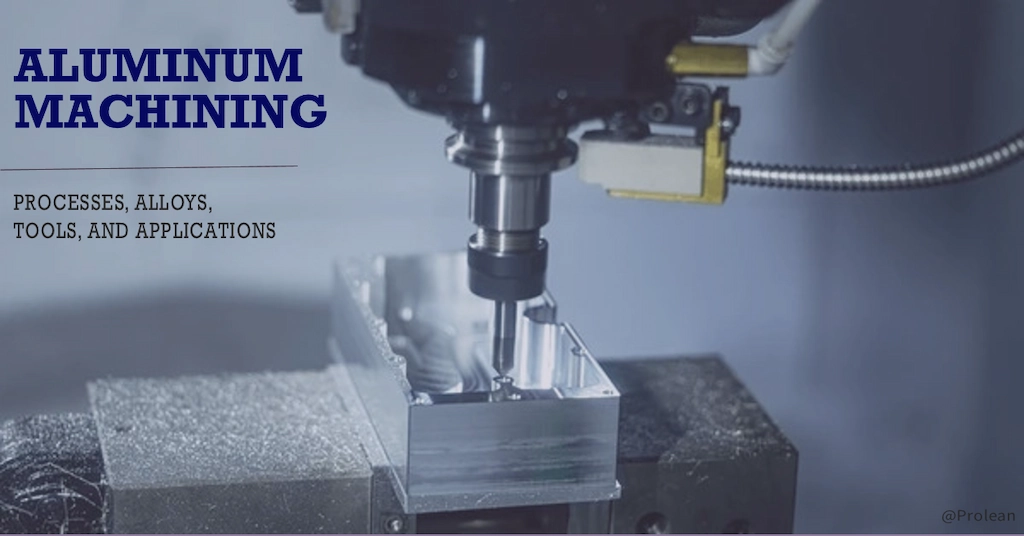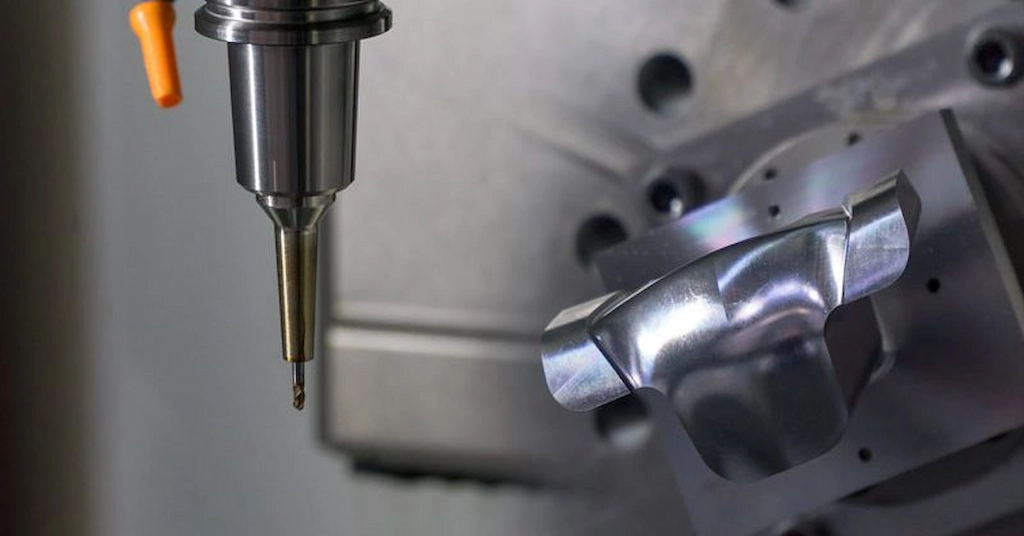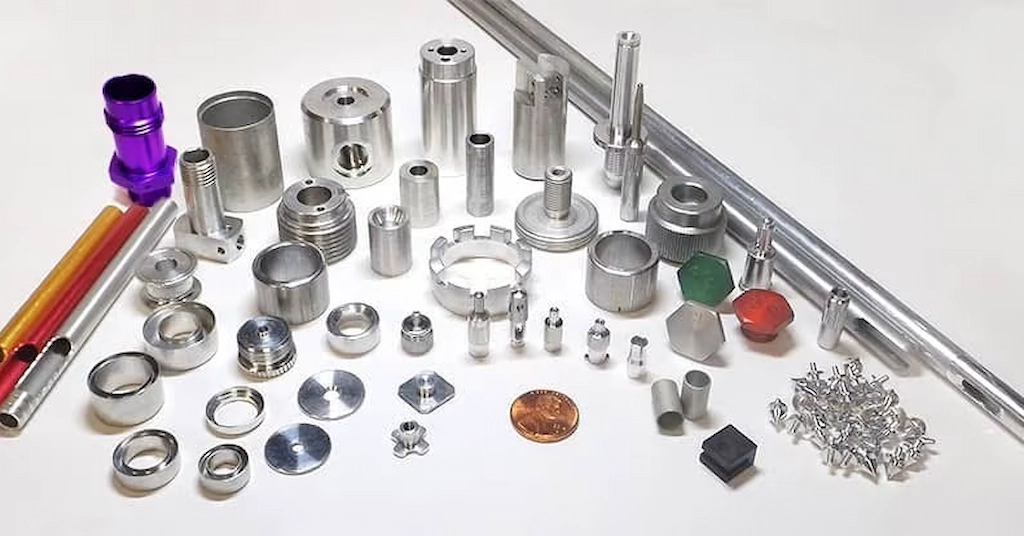“Aluminum machining involves precision cutting, drilling, and milling of aluminum parts using CNC machines. It offers high speed, excellent surface finish, and is ideal for lightweight, durable components.”

Aluminum Machining Details
Aluminum is one of the most common materials in manufacturing, with extensive uses in everything from automotive and aerospace to construction. Although there are different manufacturing methods for converting aluminum into functional parts and products, CNC machining is suitable for many applications due to its ease of use and ability to create complex shapes. Different aluminum alloy grades are used in aluminum machining depending on the final mechanical and physical properties requirements.
Aluminum at Glance: Alloys and Properties
Aluminum is one of the most common materials in manufacturing. Its lightweight, machinability, corrosion resistance, and other beneficial properties make it popular in various machining projects. Moreover, different grades of aluminum alloys are compatible with aluminum CNC machining. The variation of alloying composition helps to cater to many manufacturing needs.
The following are the common alloy grades used in CNC machining;
Aluminum 7075
It is composed of aluminum, zinc, magnesium, and copper, which offers an excellent strength-to-weight ratio. It is often used in high-stress applications, particularly in the aerospace industry. Although 7075 has good aluminum machinability, the presence of copper can make it more prone to stress corrosion cracking.
6061 is versatile and the most popular alloy in aluminum machining; it includes magnesium and silicon as primary alloying elements. The excellent machinability, corrosion resistance, strength, and toughness are the fundamental properties of this alloy grade.
Aluminum 6063
This aluminum alloy offers excellent corrosion resistance, making it suitable for indoor and outdoor applications. Its mechanical properties include moderate tensile strength and good workability.
Furthermore, the table below compares the properties of CNC machining aluminum grades;
Table: Aluminum Machining Grades
| Aluminum Alloy | Corrosion Resistance | Tensile Strength (MPa) | Yield Strength (MPa) | Machinability | Workability |
| 6061 | High | 290-310 | 240 | Good | Good |
| 7075 | Moderate | 510-540 | 430-480 | Good | Fair |
| 2024 | Moderate | 470 | 325 | Good | Fair |
| 5052 | High | 210 | 160-210 | Fair | Good |
| 6063 | High | 205 | 145 | Good | Excellent |
| 7050 | Moderate | 570 | 500 | Good | Fair |
What are the Most Common Aluminum CNC Machining Processes?

Aluminum machining process
Different tools and machining processes are employed in CNC machining to achieve the final shape, turning, milling, and drilling, are few to name. The selection of machining type or process entirely depends on the geometric features present in the Design.
- Aluminum Milling
The CNC milling process involves stationary aluminum workpieces. Meanwhile, the spindle moves across the axes with a rotating multi-point cutter to remove the material. The feeding mechanism typically involves a feeding tool towards workpiece or a combined motion of both the workpiece and cutting tool. It is mainly used for flat and irregular shapes that do not have rotational symmetry, crafting all detailed features and surface finishing.
- Aluminum Turning
In CNC turning, a single-point cutting tool remains stationary, and the rotation workpiece is fed into a tool to achieve material removal. In this process, rotating the workpiece allows cutting tools to shave away its outer material. This action reduces the diameter of the workpiece, shaping it to the specified dimensions. In this process, the rotating workpiece allows cutting tools to shave away its outer material. Subsequently, this aluminum machining type suits axially symmetric parts like cylindrical can conical geometries.
- Aluminum Drilling
Drilling makes holes of various shapes and sizes into aluminum parts. The geometry and dimension of the hole depend on the geometry and size of the drill bit, which is typically made with carbide or high-speed steels. During drilling, the rotating bit moves perpendicular to the surface of the workpiece, removing the material from the hole. Furthermore, the boring and reaming process might require for enlarging and finishing the drilled holes.
- Aluminum Electrical Discharge Machining
This aluminum parts machining process utilizes electrical sparks to erode the material from a workpiece and provides intricate shapes and features with tight tolerances. In EDM, an electrode( you can say cutting tool) and the aluminum workpiece are submerged in a dielectric fluid. Then, while passing the current, electrical discharges are created between them, which erodes the material. It is essential for complex geometries, fine details, and hard-to-machine features.
Try Prolean Now!
Cutting Tools and Parameters for Aluminum Machining
 Aluminum machining tools
Aluminum machining tools
Another essential thing to understand in CNC aluminum cutting or machining is the tool type, material, and cutting parameters. Typically, tools are made with high-speed steel or carbide. Meanwhile, each machining operation requires distinct tool types and parameters.
Before discussing tool type and material, let’s understand cutting tools’ helix and flute structure. In CNC machining of aluminum, generally, two or three flute tools with 35°, 40°, and 45° helix angles are used.
| Criteria | Definition | Description | Advantages | Applications |
| 3 Flutes | A cutting tool with three cutting edges. | It is ideal for a solid carbide endmill and balances tool strength and chip clearance. | Excellent chip clearance and tool strength. | General aluminum machining. |
| 2 Flutes | A cutting tool with two cutting edges. | It reduces cutting forces and deals with vibration; suitable for light cuts and long tools. | Lighter cutting reduces vibration. | Light, iffy cuts, long tools prone to vibration. |
| Helix Angle | The angle formed between the cutting edge and the tool’s axis. | 35° for roughing, 45° for smooth surface, and 40° for combined roughing and finishing. | Adjustable for heat management and surface finish. | Roughing and finishing |
Selecting Aluminum Cutting Tools and Parameters
The table below outlines the suggestion of tool type, material, and parameters for various aluminum machining processes and operations;
| Process/Operation | Tooling | Tool Materials | Spindle Speed | Feed Rate | Cutting Depth |
| Milling | 2-flute, 3-flute endmills | Carbide | 1000-1500 SFM | 0.005″-0.01″ per tooth | Up to 0.5xD depth |
| Turning | Turning inserts | Carbide | 1000-4000 RPM | 0.004″-0.012″ per rev | 0.1″ to 0.5″ per pass |
| Drilling | Split point drills | Carbide, HSS | 2000-6000 RPM | 0.002″-0.01″ per rev | Depth varies per hole |
| Facing | Face mills, shell mills | Carbide | 1000-3000 RPM | 0.004″-0.01″ per tooth | Light cuts (0.01″-0.1″) |
| Slotting | Endmills, slot drills | Carbide | 1000-1500 SFM | 0.005″-0.01″ per tooth | Up to 4xD depth |
| Tapping | Taps | HSS, Carbide | 200-1000 RPM | 0.001″-0.005″ per rev | Varies with thread depth |
| Facing | Face mills, shell mills | Carbide | 1000-3000 RPM | 0.004″-0.01″ per tooth | Light cuts (0.01″-0.1″) |
| EDM | EDM electrodes | Graphite, Copper | N/A | Precise, minimal material |
“Note: These values are for typical operations, and they might vary depending on the alloy type and specific requirements of your parts.”
What are the Advantages of Aluminum Machining?
- Complex Shpes and Features: The machining processes allow for intricate aluminum parts with precision, such as complex undercuts, internal channels, irregular geometries, etc. It is also beneficial for custom designs.
- Precision: The machined aluminum parts are more precise and consistent than parts produced with other manufacturing methods like casting and forging.
- Machining Speed: The aluminum machinability directly impacts the machining speed, enhancing the production efficiency.
- Finishing Options: Aluminum itself has high corrosion resistance, and it accepts other post-processing and finishing options like anodizing and powder coating.
- Cost Benefit: Aluminum parts machining is relatively less expensive than other high-strength and low-weight materials like titanium, brass, and PEEK.
- Electrical and Thermal Conductivity: It is highly electricity and heat conductive, which is suitable for electrical and thermal applications like connectors and aluminum heat sink.
Try Prolean Now!
Aluminum Machining Applications

CNC machined aluminum parts
We discuss the capabilities and benefits of aluminum CNC machining, but where these are applied in real-world industries? Aluminum applications are widespread in automotive, aerospace, electronics, medical, and many more.
Aerospace
Machining aluminum parts is essential in aerospace due to its lightweight and high-strength properties. Precision machining techniques, such as CNC milling and turning, are used to manufacture complex components like airframe parts, wing structures, and landing gear. Aluminum’s excellent machinability allows for tight tolerances and superior surface finishes.
Automotive
In the automotive industry, CNC automotive parts of aluminum enhance vehicle performance and fuel efficiency—for example, engine components, transmission cases, and chassis. The lightweight nature of aluminum helps reduce the overall weight of vehicles, leading to improved fuel economy and reduced emissions.
Electronics
The electronics uses aluminum machining for enclosures, heat sinks, and structural components for various devices. Especially the thermal conductivity of aluminum and the precision capability of CNC combined make CNC machined heat sinks popular for different electronic items.
Construction
Aluminum’s strength, lightweight, and corrosion resistance make it an ideal material for construction applications. CNC machined components can be used for building functionality and aesthetic appeal. Examples include architectural elements, window frames, and structural components.
Medical
In the medical industry, aluminum machining is used to create precision instruments, prosthetics, and equipment components. The biocompatibility and corrosion resistance of aluminum makes it suitable for medical applications. Consequently, CNC ensures the production of highly accurate and reliable parts that meet stringent medical standards.
Energy
Aluminum CNC machining is crucial in the energy sector, providing precision in manufacturing components for wind turbines, solar panels, and power distribution systems. It ensures lightweight, durable parts with tight tolerances for efficiency and reliability. For instance, wind turbine machining is popular for high-accuracy hubs.
Summing Up
Overall, aluminum machining produces lightweight, durable, and high-performance parts for several industries, including automotive, aerospace, electronics, construction, medical, and energy. Diverse machining processes like turning, milling, facing, drilling, taping, EDM, Pocketing, and many others can be employed with corresponding tooling and parameters to machine aluminum alloys.
However, advanced CNC machining equipment, tooling, and expert operators are also mandatory for precise CNC machining of aluminum. At ProleanTech, we have multi-axis(3,4,5) CNC lathes and machining centers to deliver precise aluminum parts and products. Our In-house Aluminum CNC services can handle any of your projects at a competitive cost. Request a quote and start your project today!
FAQs
What are the common aluminum machining processes?
Standard aluminum machining processes include CNC milling, turning, drilling, tapping, facing, and slotting. These methods allow for precisely shaping, cutting, and finishing aluminum components.
What aluminum alloys are used in CNC machining?
Common aluminum alloys used in CNC machining include 6061, 7075, 2024, 5052, and 6063.
Are aluminum machining parts durable?
Yes, aluminum machining parts are durable. Aluminum alloys offer a good balance of strength, corrosion resistance, and lightweight properties, ensuring that machined components perform well under various conditions and have a long service life.
Which tool materials are suitable for aluminum machining?
Carbide tools are most suitable for aluminum machining due to their hardness and ability to maintain a sharp edge. High-speed steel (HSS) can also be used, but carbide is preferred for its superior performance and longevity in machining aluminum.




Hello, i read your blog whenever i need to know anything about manufacturing processes!
I got this web site from my research assistant who told me about this web site? Do you provide anodizing service along with machining?
Yes, we providing comprehensive aluminum anodizing and other various finishing services along with CNC machining !